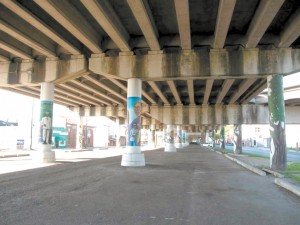Containers to create business spaces for the corridor
2nd October 2017 · 0 Comments
By Fritz Esker
Contributing Writer
Plans are underway to use shipping containers to bring new economic and cultural life to Claiborne Avenue under the interstate.
Asali Ecclesiastes, Claiborne Corridor Program Manager, said there has been a desire for decades to “make lemonade out of lemons” on Claiborne Ave.
Local residents want to restore that dreary stretch of Claiborne to something at least resembling the community-oriented space it was before the interstate was built. More recently, there was talk of installing a weekend art market on the spot, but officials and community members decided they wanted something that would be more transformative on a day-to-day basis.The project stemmed from a HUD/DOTD survey in 2011-12 that examined how the post-Katrina innovation sweeping the city could benefit the Claiborne community. City officials met with community members to discuss how they could best utilize the space under the interstate and make it welcoming for businesses and residents.
Ashleigh Gardere, senior advisor to New Orleans Mayor Mitch Landrieu, said the strongest recurring theme in these discussions was economic opportunity. Residents did not want to hear about the millions being spent on the city’s new medical complexes in Mid-City when the money would not directly benefit them. They didn’t care if the interstate stayed up or came down. They wanted businesses where they would be the owners, the managers and the workers.
“We are designing this with the community,” Gardere said.
Community members talked to design strategists who were able to convey their wishes to Meyer Engineers, the architects for the project. Ecclesiastes said the residents favored shipping containers as housing for the new developments. The containers are cheaper than new construction and are environmentally friendly. They can also be made to look like whatever the occupants want them to look like. The occupants can be creative in how they present their businesses to the community.
“They (the residents) want something that can reflect the artistic creativity that the neighborhood is known for,” Ecclesiastes said.
Ecclesiastes said it is not yet known exactly what businesses will be occupying the containers. The architects are working on the plans and are expected to have finished a draft of by late October. Once the plans have been completed, they will be submitted to the community for revision and approval. She hopes that ground will be broken on the project by the end of 2017.
Seventh Ward resident Gentelle Pedescleaux said she was happy with how the plans for the new space are going so far. She said she hoped it would become a spot that could be used by young and old residents alike.
“This is something that has to happen and will be amazing once it materializes,” Pedescleaux said.
Other residents of Tremé have differing opinions. Margaret Thomas, owner of Treme Market, expressed concerns that the sellers in the containers will not have enough of an economic nest egg to withstand lulls in sales. If working class people invest money in these businesses and they fail, it could be financially disastrous for them. She is also unsure whether the target customer base for these businesses is supposed to be tourists or locals.
As a neighborhood business owner herself, Thomas said small businesses in the area are threatened by the impending increase in competition.
“I’m not sure there will be enough commerce to go around,” Thomas said.
Amy Stelly, a resident of Dumaine Street and member of Claiborne Reborn, has a number of logistical questions. For starters, she wants to know how trash will be removed and how fire protection will be rendered. She also wants to know more about the process involved in hiring the architects.
“We have a lot of questions about the process and decision making,” Stelly said. “We want to be assured that all of the procedures and reviews are being held in the sunlight.”
Stelly shared Thomas’ concerns about what will happen if the sellers lose money. If businesses in the containers fail, then that could reduce the quality of life in the area. There would be approximately 60 shipping containers under the interstate and not all of them would be occupied. It would potentially become just a different version of blight.
Crime is also a concern to Stelly. She said that murders have recently gone down in the neighborhood, but prostitution is on the rise. She fears that the standalone bathrooms that will come with the containers will become a haven for prostitutes to ply their trade.
Stelly believes stimulating the economy in the neighborhood is a good thing, but that there are better ways to go about it. She said incentive programs and facade treatment programs could be created to help existing businesses.
“We’re not saying the intent is bad,” Stelly said. “We’re saying that the strategy that is being employed gives us pause.”
Naydja Bynum, a board member with the Historic Faubourg Tremé Association, said the organization felt like they were kept in the dark on the project.
“We feel uninformed and not included in the discussion,” said Bynum.
Requests for comment from District C Councilmember Nadine Ramsey went unanswered as of press time.
This article originally published in the October 2, 2017 print edition of The Louisiana Weekly newspaper.




